BSBMGT605 Provide Leadership: Trust, Culture, Management & Decisions
VerifiedAdded on 2023/06/10
|7
|1310
|82
Report
AI Summary
This report provides an overview of key leadership components within an organization, focusing on building trust through respect, diversity, and confidentiality. It outlines steps to improve workplace culture by emphasizing transparency, public recognition, and feedback channels. The crucial role of a manager in adapting to economic, technological, and social changes is highlighted, along with the importance of transformational leadership and employee participation in decision-making. The report details a decision-making framework that includes strategic thinking, resource management, and performance review, while also addressing the impact of risk management on organizational decisions. Finally, it emphasizes the significance of professional representation of the organization through employee conduct and communication. Desklib offers a wealth of similar resources, including past papers and solved assignments, for students seeking to deepen their understanding of leadership and management principles.

Running head: LEADERSHIP ACROSS THE ORGANIZATION
Leadership across the organization
Leadership across the organization
Paraphrase This Document
Need a fresh take? Get an instant paraphrase of this document with our AI Paraphraser
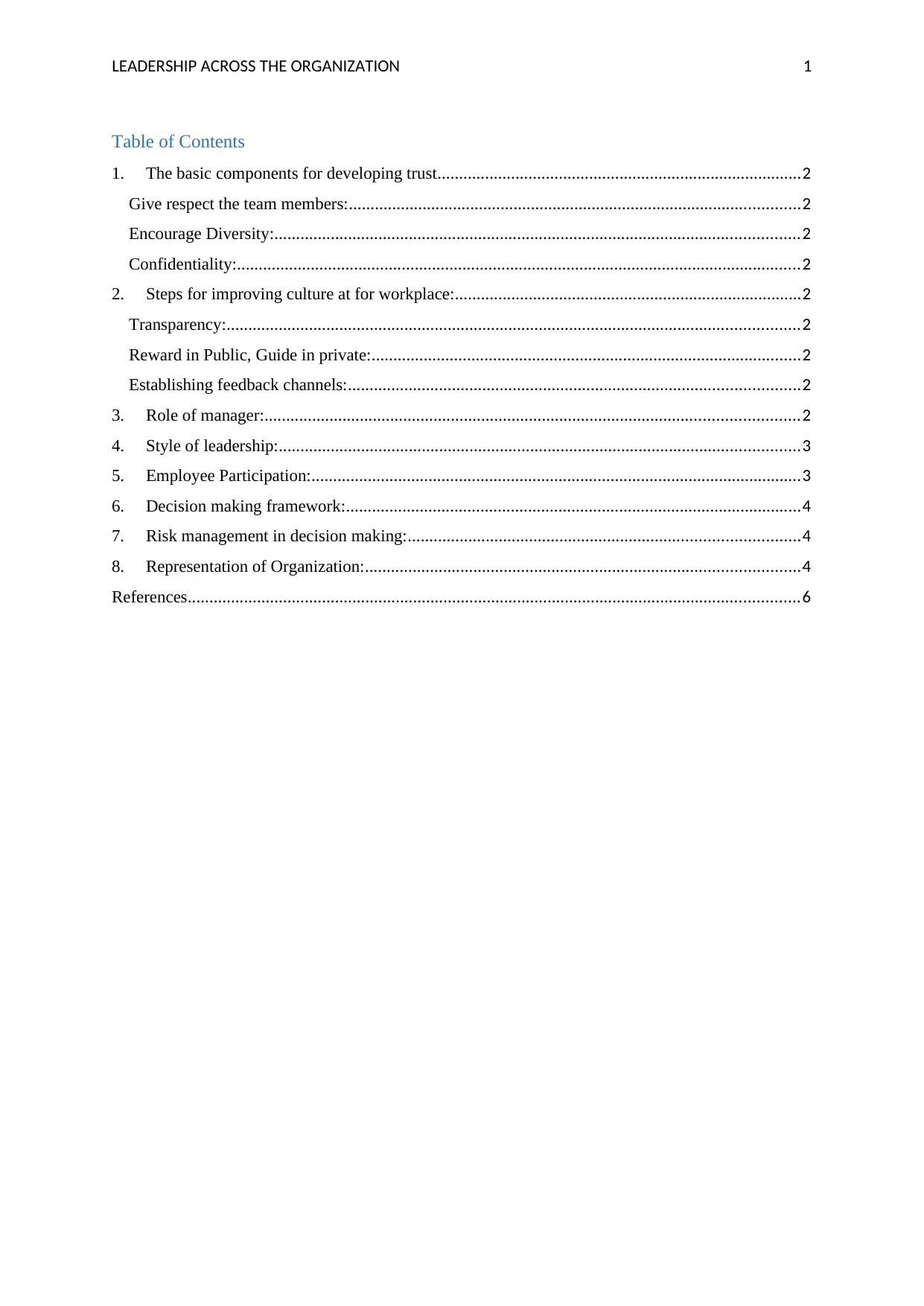
LEADERSHIP ACROSS THE ORGANIZATION 1
Table of Contents
1. The basic components for developing trust....................................................................................2
Give respect the team members:........................................................................................................2
Encourage Diversity:.........................................................................................................................2
Confidentiality:..................................................................................................................................2
2. Steps for improving culture at for workplace:................................................................................2
Transparency:....................................................................................................................................2
Reward in Public, Guide in private:...................................................................................................2
Establishing feedback channels:........................................................................................................2
3. Role of manager:...........................................................................................................................2
4. Style of leadership:........................................................................................................................3
5. Employee Participation:.................................................................................................................3
6. Decision making framework:.........................................................................................................4
7. Risk management in decision making:..........................................................................................4
8. Representation of Organization:....................................................................................................4
References.............................................................................................................................................6
Table of Contents
1. The basic components for developing trust....................................................................................2
Give respect the team members:........................................................................................................2
Encourage Diversity:.........................................................................................................................2
Confidentiality:..................................................................................................................................2
2. Steps for improving culture at for workplace:................................................................................2
Transparency:....................................................................................................................................2
Reward in Public, Guide in private:...................................................................................................2
Establishing feedback channels:........................................................................................................2
3. Role of manager:...........................................................................................................................2
4. Style of leadership:........................................................................................................................3
5. Employee Participation:.................................................................................................................3
6. Decision making framework:.........................................................................................................4
7. Risk management in decision making:..........................................................................................4
8. Representation of Organization:....................................................................................................4
References.............................................................................................................................................6
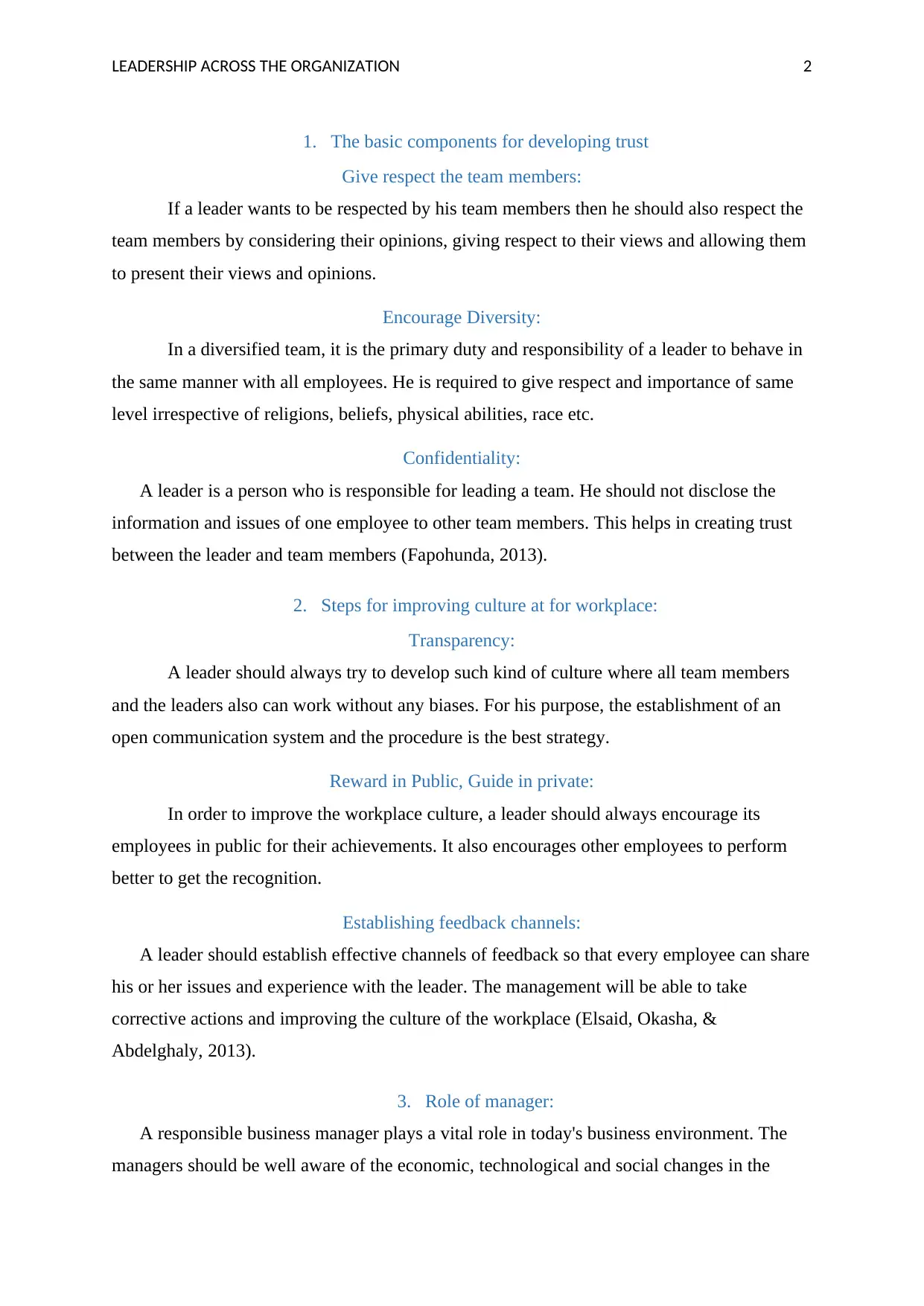
LEADERSHIP ACROSS THE ORGANIZATION 2
1. The basic components for developing trust
Give respect the team members:
If a leader wants to be respected by his team members then he should also respect the
team members by considering their opinions, giving respect to their views and allowing them
to present their views and opinions.
Encourage Diversity:
In a diversified team, it is the primary duty and responsibility of a leader to behave in
the same manner with all employees. He is required to give respect and importance of same
level irrespective of religions, beliefs, physical abilities, race etc.
Confidentiality:
A leader is a person who is responsible for leading a team. He should not disclose the
information and issues of one employee to other team members. This helps in creating trust
between the leader and team members (Fapohunda, 2013).
2. Steps for improving culture at for workplace:
Transparency:
A leader should always try to develop such kind of culture where all team members
and the leaders also can work without any biases. For his purpose, the establishment of an
open communication system and the procedure is the best strategy.
Reward in Public, Guide in private:
In order to improve the workplace culture, a leader should always encourage its
employees in public for their achievements. It also encourages other employees to perform
better to get the recognition.
Establishing feedback channels:
A leader should establish effective channels of feedback so that every employee can share
his or her issues and experience with the leader. The management will be able to take
corrective actions and improving the culture of the workplace (Elsaid, Okasha, &
Abdelghaly, 2013).
3. Role of manager:
A responsible business manager plays a vital role in today's business environment. The
managers should be well aware of the economic, technological and social changes in the
1. The basic components for developing trust
Give respect the team members:
If a leader wants to be respected by his team members then he should also respect the
team members by considering their opinions, giving respect to their views and allowing them
to present their views and opinions.
Encourage Diversity:
In a diversified team, it is the primary duty and responsibility of a leader to behave in
the same manner with all employees. He is required to give respect and importance of same
level irrespective of religions, beliefs, physical abilities, race etc.
Confidentiality:
A leader is a person who is responsible for leading a team. He should not disclose the
information and issues of one employee to other team members. This helps in creating trust
between the leader and team members (Fapohunda, 2013).
2. Steps for improving culture at for workplace:
Transparency:
A leader should always try to develop such kind of culture where all team members
and the leaders also can work without any biases. For his purpose, the establishment of an
open communication system and the procedure is the best strategy.
Reward in Public, Guide in private:
In order to improve the workplace culture, a leader should always encourage its
employees in public for their achievements. It also encourages other employees to perform
better to get the recognition.
Establishing feedback channels:
A leader should establish effective channels of feedback so that every employee can share
his or her issues and experience with the leader. The management will be able to take
corrective actions and improving the culture of the workplace (Elsaid, Okasha, &
Abdelghaly, 2013).
3. Role of manager:
A responsible business manager plays a vital role in today's business environment. The
managers should be well aware of the economic, technological and social changes in the
⊘ This is a preview!⊘
Do you want full access?
Subscribe today to unlock all pages.

Trusted by 1+ million students worldwide
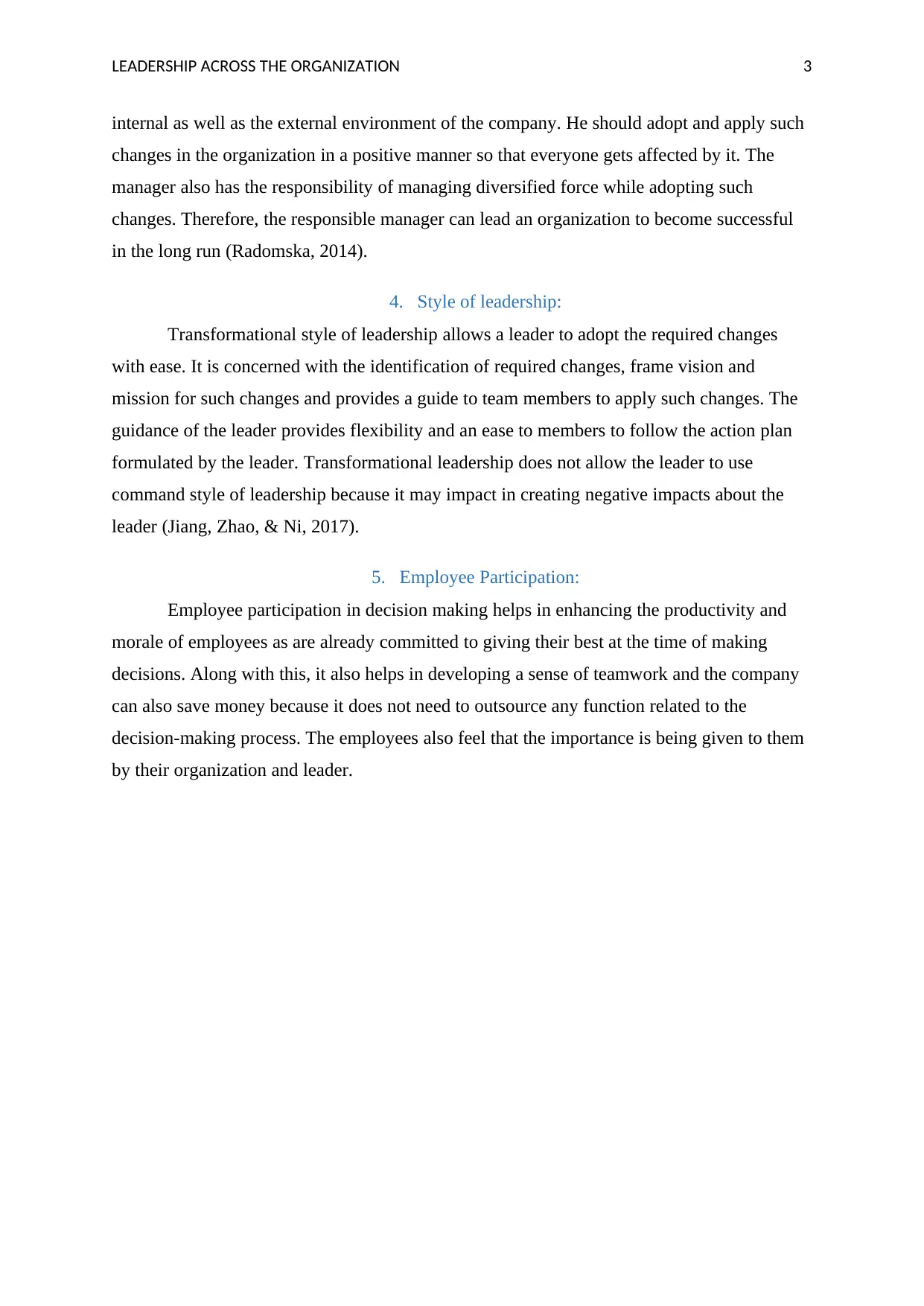
LEADERSHIP ACROSS THE ORGANIZATION 3
internal as well as the external environment of the company. He should adopt and apply such
changes in the organization in a positive manner so that everyone gets affected by it. The
manager also has the responsibility of managing diversified force while adopting such
changes. Therefore, the responsible manager can lead an organization to become successful
in the long run (Radomska, 2014).
4. Style of leadership:
Transformational style of leadership allows a leader to adopt the required changes
with ease. It is concerned with the identification of required changes, frame vision and
mission for such changes and provides a guide to team members to apply such changes. The
guidance of the leader provides flexibility and an ease to members to follow the action plan
formulated by the leader. Transformational leadership does not allow the leader to use
command style of leadership because it may impact in creating negative impacts about the
leader (Jiang, Zhao, & Ni, 2017).
5. Employee Participation:
Employee participation in decision making helps in enhancing the productivity and
morale of employees as are already committed to giving their best at the time of making
decisions. Along with this, it also helps in developing a sense of teamwork and the company
can also save money because it does not need to outsource any function related to the
decision-making process. The employees also feel that the importance is being given to them
by their organization and leader.
internal as well as the external environment of the company. He should adopt and apply such
changes in the organization in a positive manner so that everyone gets affected by it. The
manager also has the responsibility of managing diversified force while adopting such
changes. Therefore, the responsible manager can lead an organization to become successful
in the long run (Radomska, 2014).
4. Style of leadership:
Transformational style of leadership allows a leader to adopt the required changes
with ease. It is concerned with the identification of required changes, frame vision and
mission for such changes and provides a guide to team members to apply such changes. The
guidance of the leader provides flexibility and an ease to members to follow the action plan
formulated by the leader. Transformational leadership does not allow the leader to use
command style of leadership because it may impact in creating negative impacts about the
leader (Jiang, Zhao, & Ni, 2017).
5. Employee Participation:
Employee participation in decision making helps in enhancing the productivity and
morale of employees as are already committed to giving their best at the time of making
decisions. Along with this, it also helps in developing a sense of teamwork and the company
can also save money because it does not need to outsource any function related to the
decision-making process. The employees also feel that the importance is being given to them
by their organization and leader.
Paraphrase This Document
Need a fresh take? Get an instant paraphrase of this document with our AI Paraphraser
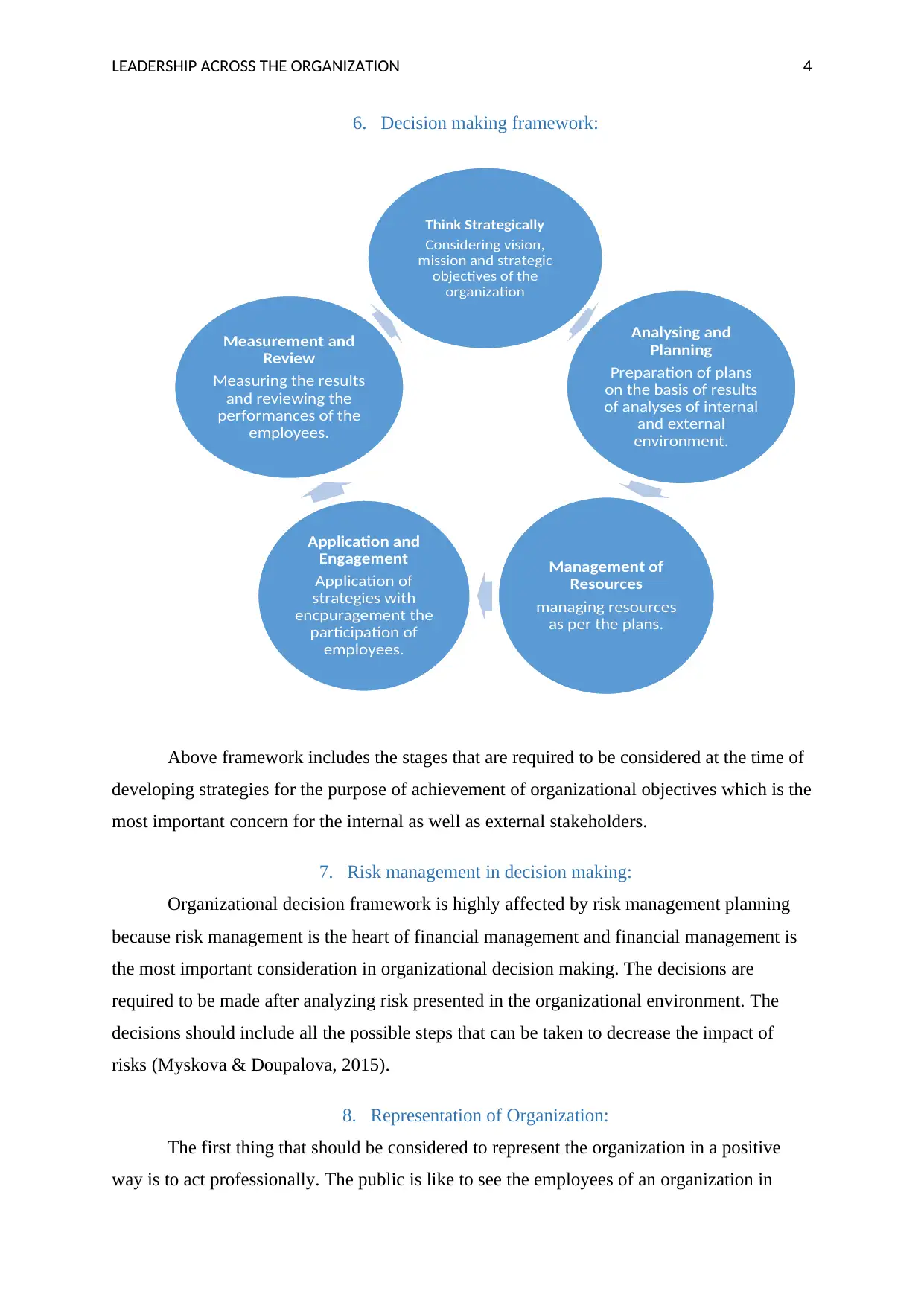
LEADERSHIP ACROSS THE ORGANIZATION 4
6. Decision making framework:
Above framework includes the stages that are required to be considered at the time of
developing strategies for the purpose of achievement of organizational objectives which is the
most important concern for the internal as well as external stakeholders.
7. Risk management in decision making:
Organizational decision framework is highly affected by risk management planning
because risk management is the heart of financial management and financial management is
the most important consideration in organizational decision making. The decisions are
required to be made after analyzing risk presented in the organizational environment. The
decisions should include all the possible steps that can be taken to decrease the impact of
risks (Myskova & Doupalova, 2015).
8. Representation of Organization:
The first thing that should be considered to represent the organization in a positive
way is to act professionally. The public is like to see the employees of an organization in
Think Strategically
Considering vision,
mission and strategic
objectives of the
organization
Analysing and
Planning
Preparation of plans
on the basis of results
of analyses of internal
and external
environment.
Management of
Resources
managing resources
as per the plans.
Application and
Engagement
Application of
strategies with
encpuragement the
participation of
employees.
Measurement and
Review
Measuring the results
and reviewing the
performances of the
employees.
6. Decision making framework:
Above framework includes the stages that are required to be considered at the time of
developing strategies for the purpose of achievement of organizational objectives which is the
most important concern for the internal as well as external stakeholders.
7. Risk management in decision making:
Organizational decision framework is highly affected by risk management planning
because risk management is the heart of financial management and financial management is
the most important consideration in organizational decision making. The decisions are
required to be made after analyzing risk presented in the organizational environment. The
decisions should include all the possible steps that can be taken to decrease the impact of
risks (Myskova & Doupalova, 2015).
8. Representation of Organization:
The first thing that should be considered to represent the organization in a positive
way is to act professionally. The public is like to see the employees of an organization in
Think Strategically
Considering vision,
mission and strategic
objectives of the
organization
Analysing and
Planning
Preparation of plans
on the basis of results
of analyses of internal
and external
environment.
Management of
Resources
managing resources
as per the plans.
Application and
Engagement
Application of
strategies with
encpuragement the
participation of
employees.
Measurement and
Review
Measuring the results
and reviewing the
performances of the
employees.
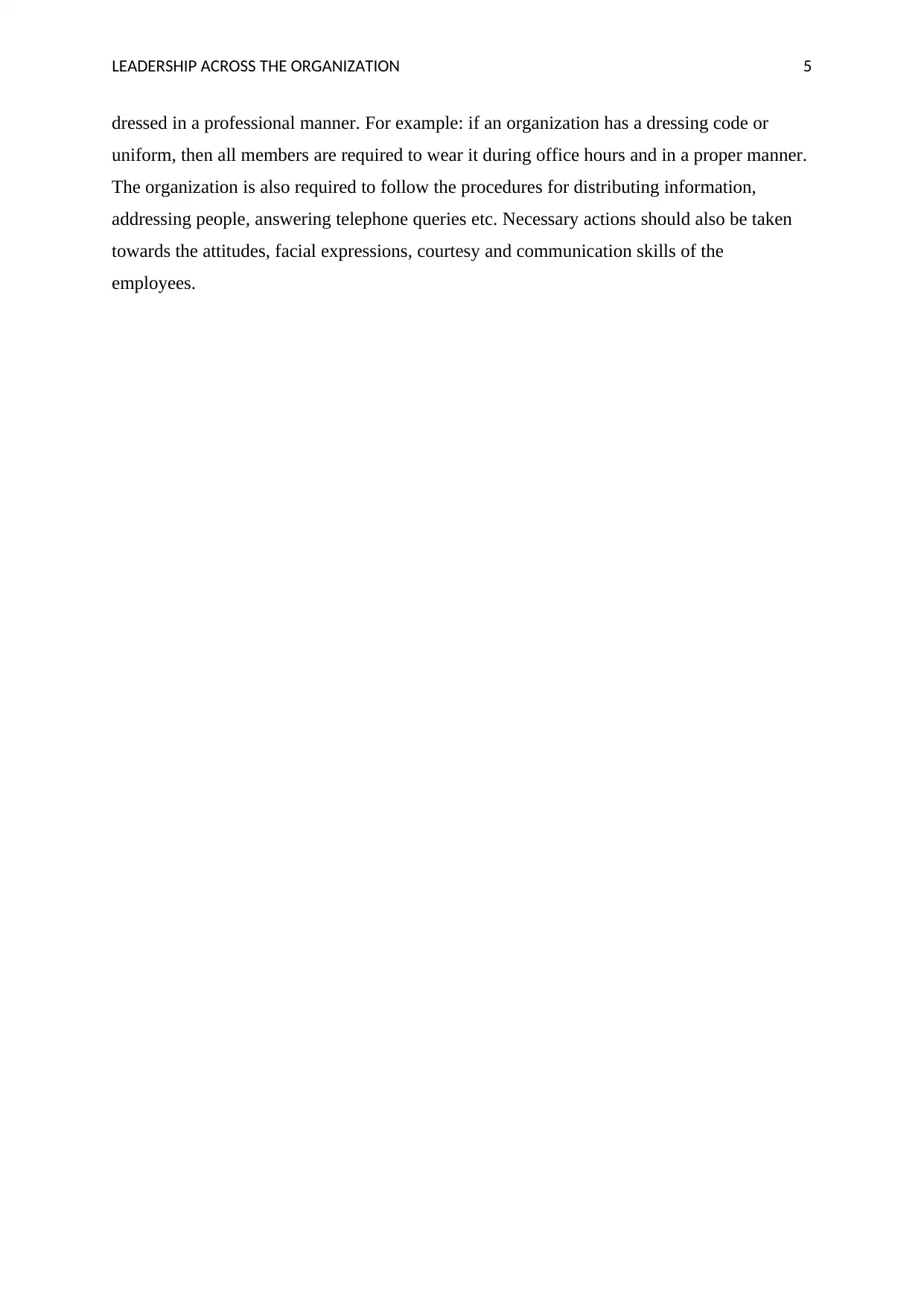
LEADERSHIP ACROSS THE ORGANIZATION 5
dressed in a professional manner. For example: if an organization has a dressing code or
uniform, then all members are required to wear it during office hours and in a proper manner.
The organization is also required to follow the procedures for distributing information,
addressing people, answering telephone queries etc. Necessary actions should also be taken
towards the attitudes, facial expressions, courtesy and communication skills of the
employees.
dressed in a professional manner. For example: if an organization has a dressing code or
uniform, then all members are required to wear it during office hours and in a proper manner.
The organization is also required to follow the procedures for distributing information,
addressing people, answering telephone queries etc. Necessary actions should also be taken
towards the attitudes, facial expressions, courtesy and communication skills of the
employees.
⊘ This is a preview!⊘
Do you want full access?
Subscribe today to unlock all pages.

Trusted by 1+ million students worldwide
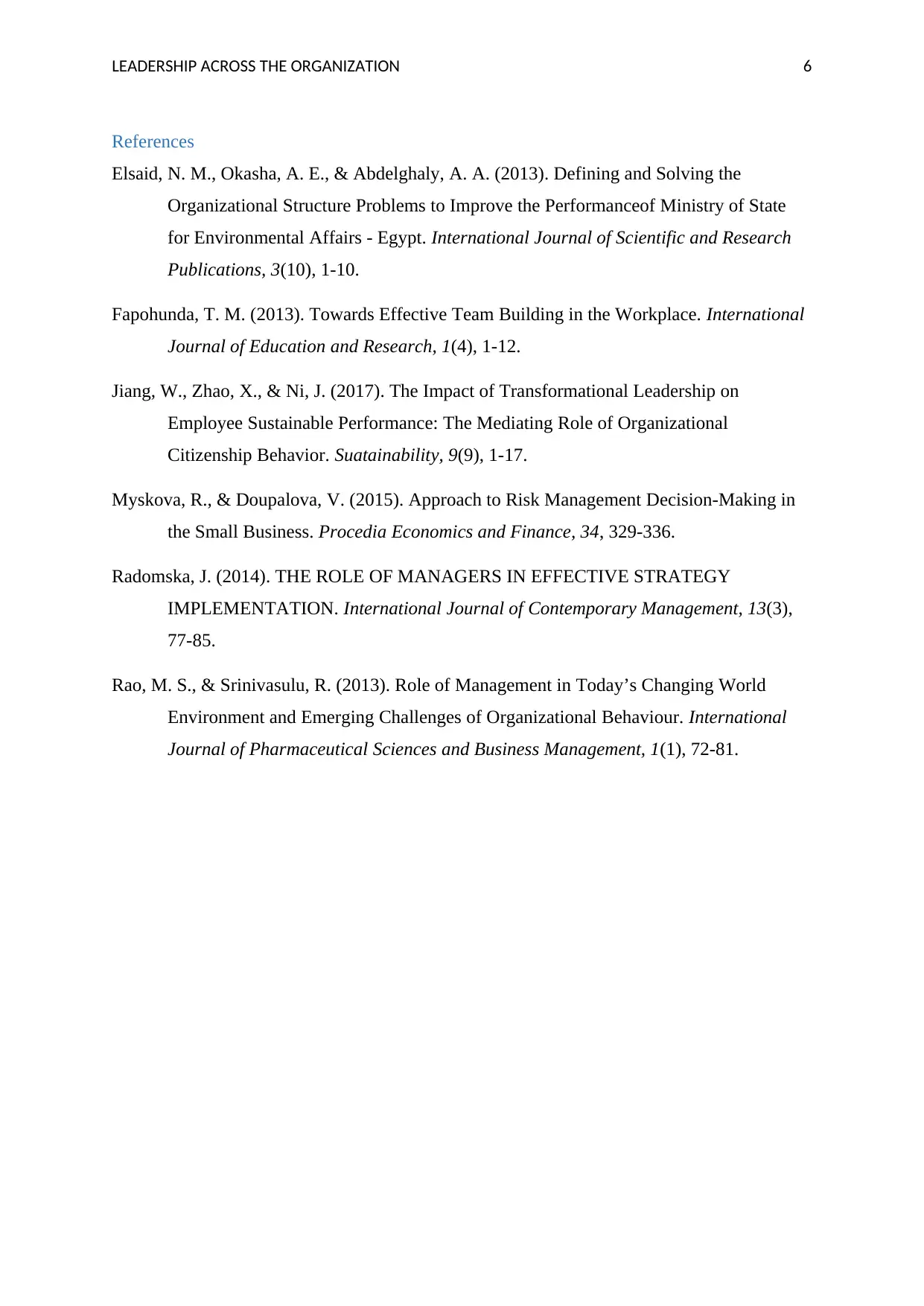
LEADERSHIP ACROSS THE ORGANIZATION 6
References
Elsaid, N. M., Okasha, A. E., & Abdelghaly, A. A. (2013). Defining and Solving the
Organizational Structure Problems to Improve the Performanceof Ministry of State
for Environmental Affairs - Egypt. International Journal of Scientific and Research
Publications, 3(10), 1-10.
Fapohunda, T. M. (2013). Towards Effective Team Building in the Workplace. International
Journal of Education and Research, 1(4), 1-12.
Jiang, W., Zhao, X., & Ni, J. (2017). The Impact of Transformational Leadership on
Employee Sustainable Performance: The Mediating Role of Organizational
Citizenship Behavior. Suatainability, 9(9), 1-17.
Myskova, R., & Doupalova, V. (2015). Approach to Risk Management Decision-Making in
the Small Business. Procedia Economics and Finance, 34, 329-336.
Radomska, J. (2014). THE ROLE OF MANAGERS IN EFFECTIVE STRATEGY
IMPLEMENTATION. International Journal of Contemporary Management, 13(3),
77-85.
Rao, M. S., & Srinivasulu, R. (2013). Role of Management in Today’s Changing World
Environment and Emerging Challenges of Organizational Behaviour. International
Journal of Pharmaceutical Sciences and Business Management, 1(1), 72-81.
References
Elsaid, N. M., Okasha, A. E., & Abdelghaly, A. A. (2013). Defining and Solving the
Organizational Structure Problems to Improve the Performanceof Ministry of State
for Environmental Affairs - Egypt. International Journal of Scientific and Research
Publications, 3(10), 1-10.
Fapohunda, T. M. (2013). Towards Effective Team Building in the Workplace. International
Journal of Education and Research, 1(4), 1-12.
Jiang, W., Zhao, X., & Ni, J. (2017). The Impact of Transformational Leadership on
Employee Sustainable Performance: The Mediating Role of Organizational
Citizenship Behavior. Suatainability, 9(9), 1-17.
Myskova, R., & Doupalova, V. (2015). Approach to Risk Management Decision-Making in
the Small Business. Procedia Economics and Finance, 34, 329-336.
Radomska, J. (2014). THE ROLE OF MANAGERS IN EFFECTIVE STRATEGY
IMPLEMENTATION. International Journal of Contemporary Management, 13(3),
77-85.
Rao, M. S., & Srinivasulu, R. (2013). Role of Management in Today’s Changing World
Environment and Emerging Challenges of Organizational Behaviour. International
Journal of Pharmaceutical Sciences and Business Management, 1(1), 72-81.
1 out of 7
Related Documents
Your All-in-One AI-Powered Toolkit for Academic Success.
+13062052269
info@desklib.com
Available 24*7 on WhatsApp / Email
![[object Object]](/_next/static/media/star-bottom.7253800d.svg)
Unlock your academic potential
Copyright © 2020–2025 A2Z Services. All Rights Reserved. Developed and managed by ZUCOL.




